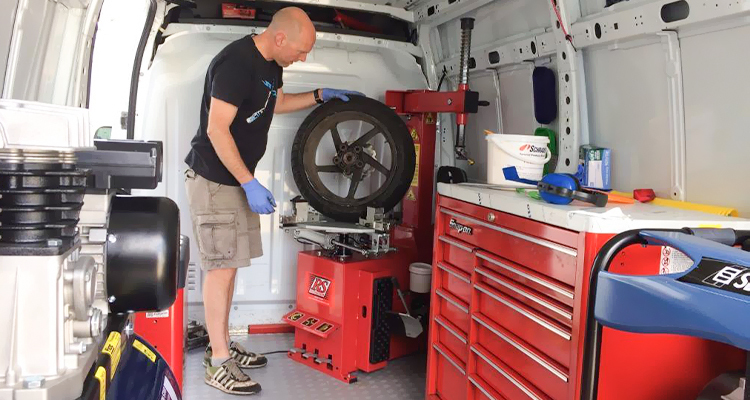Tire Service: Proven Techniques for Optimal Tire Maintenance and Treatment
Maintaining optimum tire condition is extremely important for both safety and security and performance of any vehicle. From making sure correct tire stress to normal turning and placement, there are proven approaches that can substantially expand the life expectancy of your tires and enhance overall driving experience. As we discover the intricacies of tire treatment and upkeep, we will certainly discover essential guidelines that every lorry owner need to stick to for the very best feasible outcomes. Allow's explore the globe of tire solution and discover the tricks to maintaining your tires in first-class shape for the long run.
Significance of Tire Pressure
Sufficient tire pressure advertises much better gas efficiency, as under-inflated tires can lead to increased rolling resistance, triggering the engine to work harder and consume even more gas. Proper tire pressure ensures also step wear, improving tire durability and conserving money in the lengthy run by delaying the requirement for premature substitutes. Regularly inspecting and readjusting tire pressure, especially in the past long journeys, is a basic yet efficient method to improve vehicle efficiency, expand tire lifespan, and focus on security on the roadway.
Tire Turning Standards
When thinking about tire rotation standards, it is important to recognize the relevance of this maintenance job in making best use of tire life expectancy and maintaining optimum lorry performance. Tire turning includes changing the position of each tire on an automobile to make certain even walk wear. Front tires often tend to put on quicker than back tires as a result of steering forces, making routine rotation crucial for balanced wear patterns. The suggested turning pattern differs relying on whether an automobile is front-wheel, rear-wheel, all-wheel, or 4x4. Usually, tires must be revolved every 5,000 to 7,500 miles, or as recommended in the vehicle guidebook. Disregarding tire turning can lead to irregular wear, affecting handling, grip, and possibly compromising automobile security. By adhering to proper turning guidelines, vehicle drivers can extend the life of their tires, enhance fuel effectiveness, and boost total driving experience. Routine turning is a straightforward yet effective maintenance method that contributes substantially to tire long life and car efficiency.

Benefits of Wheel Placement
Ensuring appropriate wheel positioning after tire turning is crucial for keeping balanced wear patterns and making best use of vehicle efficiency. Wheel placement describes the change of the angles of the wheels to the supplier's specifications. Among the vital benefits of wheel placement is enhanced steering and taking care of action. When the wheels are correctly straightened, it decreases guiding initiative, making sure a smoother and extra controlled driving experience. In addition, proper wheel alignment aids to extend the lifespan of your tires. Misaligned wheels can trigger uneven tire wear, leading to early tire replacement and enhanced upkeep prices.

Tire Footstep Depth Inspect
Executing a normal examination of tire step depth is essential for keeping secure driving problems and prolonging the lifespan of your tires. Irregular step wear can suggest problems with tire suspension, pressure, or alignment, highlighting the importance of normal walk depth checks. By including tire walk deepness checks right into your routine upkeep routine, you can drive with confidence knowing that your tires are in top condition.
Seasonal Tire Assessment
An extensive analysis of tire problem tailored to specific climate condition is essential for keeping ideal performance and safety and security throughout the year. Seasonal tire assessment is a fundamental facet of tire upkeep that makes certain tires prepare to face the obstacles presented by different weather problems. To prepare for winter season, it is important more tips here to examine the tire pressure regularly as chilly temperatures can create tire pressure to go down. Evaluating tire tread depth is additionally crucial to make certain appropriate traction on snow and frozen roads. Furthermore, looking for indicators of deterioration, such as cracks or lumps, can assist prevent possible tire failings. As the seasons adjustment, it is important to analyze tire condition and make any type of essential changes to ensure risk-free driving. By conducting regular seasonal tire evaluations, chauffeurs can extend tire life-span, enhance fuel performance, and most notably, ensure a protected driving experience in differing climate condition - Mobile Tire Change Las Vegas.
Conclusion
To conclude, keeping appropriate tire pressure, revolving tires consistently, lining up wheels correctly, monitoring step depth, and conducting seasonal examinations are crucial techniques for ideal tire care. By adhering to these shown methods, vehicle drivers can guarantee their tires last longer, do much better, and add to general car safety and security. It is very important to prioritize tire upkeep to protect against accidents, boost gas efficiency, click reference and lengthen the life expectancy of tires.
Adequate tire stress advertises far better fuel effectiveness, as under-inflated tires can lead to boosted rolling resistance, causing the engine to function more difficult and eat more gas.When thinking about tire rotation standards, it is necessary to comprehend the importance of this upkeep job in making best use of tire life-span and preserving optimum vehicle performance. Seasonal tire inspection is an essential facet of tire upkeep that makes sure tires are prepared to deal with the obstacles posed by various weather condition problems. By conducting regular seasonal tire evaluations, vehicle drivers can prolong tire life-span, enhance fuel efficiency, and most significantly, next make sure a safe and secure driving experience in differing climate problems.
In verdict, keeping proper tire stress, rotating tires on a regular basis, straightening wheels appropriately, monitoring tread deepness, and carrying out seasonal examinations are crucial techniques for optimal tire treatment.